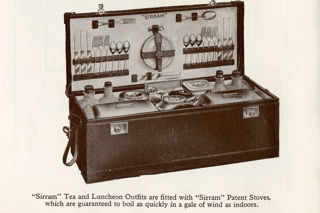
Packing for a 1920s Caravan Holiday
15 February 2020
The increasing popularity of trailer caravanning in the 1920s encouraged a rise in practical accessories suitable for life on the road. Take a look at some of the must-have caravanning essentials and accessories from a century ago.
It has been one hundred years since the trailer caravan was fast becoming the most fashionable way to enjoy a touring holiday, as an increasing number of British motorists hitched up. In the 1920s business was booming for the manufacturers of these modern and lightweight caravans, which succeeded the more cumbersome and slow-paced horse drawn leisure ´vans. The craze also created a demand for flexible and portable accessories suitable for motoring and camping trips, these are featured in beautifully illustrated advertising booklets for Eccles Caravans of Birmingham housed in the Caravan and Motorhome Club Collection and the National Motor Museum Trust’s Reference Library Collection.

The Portable Bathroom
In today’s range of caravans a closet with a toilet, shower and wash basin is standard, but in the first trailer caravans of the 1920s the ‘bathroom’ was much more primitive. A few caravans could be found with a closet containing a ‘chemical toilet’ and perhaps a sink, but these were at the luxury end of the market. For the more frugal caravanner, other solutions had to be found in a time before there were managed sites with toilet blocks.
The ‘Portable Lavatory’ was a popular alternative, with a basic design and concept which has barely changed in nearly 100 years, similar can still be bought by campers today. A tall and narrow tent, it is described in an advert from 1926: ‘It is large enough to be of practical use, and solves the problem, which is otherwise somewhat difficult when there are ladies in the party.’ It goes on to explain ‘With it is provided a folding seat. The usual procedure is to dig a small trench and set the screen around this, using it as an earth closet.’ Some early caravanners even took their own, much grander, wooden chairs with the seat section removed!
For washing, again there were accessories like portable baths and wash basins made of a folding wooden support and waterproofed fabric, which could be used in the space outside the caravan.

Lean-to’s and Tents
From the pioneering days of horse-drawn leisure caravanning in the late Victorian and Edwardian eras, the caravan itself has never quite been big enough when taking a large group on a lengthy holiday. The answer to expand space was the ‘lean-to’, a type of tent today more commonly known today as an awning. In the horse-drawn caravanning days of the early 1900s, when caravanners were often extremely wealthy, it was not uncommon for servants to accompany the trip to help with the daily chores. These servants were never permitted to sleep in the caravan itself, which was the home of the employer. Servants’ quarters when on the road were often in the less refined lean-to or tent.
By the 1920s, additional accommodation and shelter continued to be popular. At this time the majority of caravans were quite compact in order to be towed by the average motor car, and a tent outside was often used as extra accommodation for larger families.
The Wireless
The portable wireless saw a surge in mainstream popularity in the 1920s. For caravanners, taking a wireless on tour enabled them to listen to radio broadcasts while travelling. Taking a wireless on a caravan holiday was openly encouraged by hire companies and wireless manufacturers; it soon became a must-have accessory.
One caravanner noted in 1925 “Our wireless set proved a huge asset, as amidst the uncertainties of April weather it furnished a fairly accurate idea of the morrow’s possibilities. As the caravan has a Yale lock, it is quite safe to leave it untenanted and go off on the car to any neighbouring places of interest.”

The Picnic Basket
First made popular by Queen Victoria and her family in the 1800s, picnics quickly became a favourite British pastime. Picnics were an ideal way for caravanners to enjoy lunch when travelling to their destination, in a time when there were no services offering sandwiches and fast food on the road. The only option for the motorist in the 1920s was the Inn or tea rooms, so picnic hampers specially designed for the motor car offered a great alternative.

Subscribe for updates
Get our latest news and events straight to your inbox.